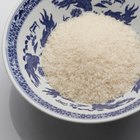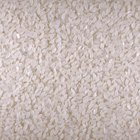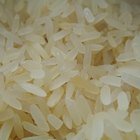
Starchy grains and roots are among the world's most important crops, valued both as foods in their own right and as ingredients in other dishes. For example, flour and cornstarch are used as thickeners in the United States, while tropical countries use arrowroot or tapioca and Asians often turn to rice flour. These alternative thickeners share many characteristics with flour and cornstarch, including their need for heat to make them work.
How Starches Thicken
If you stir rice flour or any other culinary starch into cold water, the water slowly seeps into the starch molecules. This provides a very slight degree of thickening by binding up some of the water, but the end result is just a thick, starchy sludge at the bottom of the glass. If you heat the water, the starches begin to change. The molecules expand and unwind, eventually bursting in the hot liquid. The long, unwound starch molecules form a sort of invisible sponge, immobilizing the moisture and thickening your sauce.
Thickening with Rice Flour
Rice flour is roughly comparable to wheat flour in its thickening ability, so it can be substituted directly to make a wheat-free or gluten-free sauce. Whisk the rice flour into a small quantity of cold water, to make a slurry, then stir the slurry into your sauce and bring it to a simmer. The rice flour begins to thicken noticeably at a temperature of about 125 degrees Fahrenheit, reaching its maximum thickening effect at 150 to 160 F. If you continue cooking and stirring past that point, the molecular bonds break and the rice flour begins to lose its thickening power.
The End Result
Wheat flour produces an opaque, hearty-looking sauce that's appreciated in gravies and some other applications. Rice flour results in a very clear sauce, which can be especially attractive in sauces intended to have a vivid color. However, rice flour varies widely in its fineness depending on the brand and the type of rice used. If you have the opportunity to choose between brands, rub a small amount of each between your fingertips. Choose the flour that feels finest, which results in the smoothest sauce.
Using Rice Starch
If you have an Asian market in your area, you might also be able to find purified rice starch to use as a thickener. Rice starch has the finest particle size of all the major starch thickeners and produces an especially silky-smooth sauce as a result. Like cornstarch and other purified starches, it's a more powerful thickener than wheat or rice flour, so you'll only need half as much. Use it in the same way as rice flour, mixing it first in cold water and then stirring it into your sauce.
Related Articles

Differences Between Tapioca Starch and ...

Corn Starch Vs. Baking Powder in Cooking

How to Cook Long Grain Rice

How Long After a Sell-By Date Can You ...

How to Remove Starch From Rice

How to Make a Rice Necklace

How to Cook Red Camargue Rice

Can You Use Bread Flour Instead of ...

What Is a Semibrown Rice Zojirushi?

Corn Starch Vs. Rice Flour As ...
How to Cook Volcano Rice

Differences Between Steamed & Boiled ...

Does Rice Taste Different Depending on ...

How to Extract Starch From Rice Bran

How to Bake With Rice & Potato Flours

How to Cook Rice in Foil

How to Cook Japanese Rice

How Long Can I Store Uncooked Jasmine ...

How to Cook Rice Without a Rice Cooker

How to Make Sushi Rice With Vinegar
References
- On Food and Cooking: The Science and Lore of the Kitchen; Harold McGee
- University of Sydney: New Applications for Rice Flour; Phillip Williams, et al.
Writer Bio
Fred Decker is a trained chef and prolific freelance writer. In previous careers, he sold insurance and mutual funds, and was a longtime retailer. He was educated at Memorial University of Newfoundland and the Northern Alberta Institute of Technology. His articles have appeared on numerous home and garden sites including GoneOutdoors, TheNest and eHow.
Photo Credits
Jupiterimages/Photos.com/Getty Images